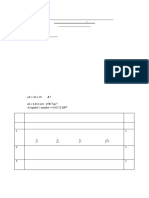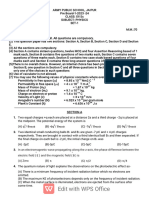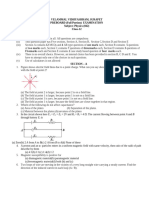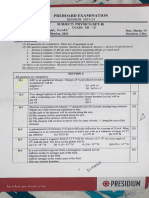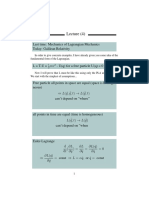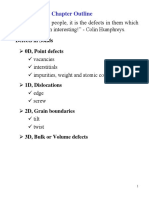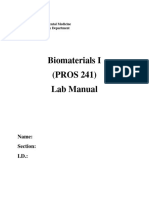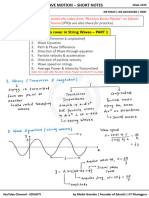Physics Class Xii Sample Paper Test 06 For Board Exam 2024
Physics Class Xii Sample Paper Test 06 For Board Exam 2024
Uploaded by
s15089a.shubham14646Copyright:
Available Formats
Physics Class Xii Sample Paper Test 06 For Board Exam 2024
Physics Class Xii Sample Paper Test 06 For Board Exam 2024
Uploaded by
s15089a.shubham14646Original Description:
Original Title
Copyright
Available Formats
Share this document
Did you find this document useful?
Is this content inappropriate?
Copyright:
Available Formats
Physics Class Xii Sample Paper Test 06 For Board Exam 2024
Physics Class Xii Sample Paper Test 06 For Board Exam 2024
Uploaded by
s15089a.shubham14646Copyright:
Available Formats
PM SHRI KENDRIYA VIDYALAYA GACHIBOWLI, GPRA CAMPUS, HYD-32
SAMPLE PAPER TEST 06 FOR BOARD EXAM 2024
SUBJECT: PHYSICS MAX. MARKS : 70
CLASS : XII DURATION: 3 HRS
General Instructions:
1. There are 33 questions in all. All questions are compulsory
2. This question paper has five sections: Section A, Section B, Section C, Section D and Section E.
All the sections are compulsory.
3. Section A contains sixteen questions, twelve MCQ and four Assertion-Reasoning based questions
of 1 mark each, Section B contains five questions of two marks each, Section C contains seven
questions of three marks each, Section D contains two case study based questions of 4 marks each
and Section E contains three long questions of five marks each
4. There is no overall choice. However, an internal choice has been provided in section B, C, D and
E. You have to attempt only one of the choices in such questions.
5. Use of calculators is not allowed.
SECTION – A
Questions 1 to 16 carry 1 mark each.
1. Two point charges +8q and -2q are located at x = 0 and x = L respectively. The point on x axis at
which net electric field is zero due to these charges is
(a) 8L (b) 4L (c) 2L (d) L
2. The magnetic flux through a circuit of resistance R changes by an amount ∆ in time ∆t, then the
total quantity of electric charge Q, passing during this time through any point of the circuit is
given by
(a) Q (b) Q R (c) Q R (d) Q
t t t R
3. Match the followings in Column A having correct appropriate properties with in Column B.
Column A Column B
(i) Diamagnetic Substance (p) Strongly attracted by magnets
(ii) Paramagnetic substance (q) Weakly attracted by magnets
(iii) Ferromagnetic substance (r) Weakly repelled by magnets
(s) µr is slightly greater than 1.
(a) (i)-(q), (ii)-(r),(iii) (s), (p) (b) (i)-(q), (s) (ii)-(p), (iii)-(r)
(c) (i)-(r), (ii)-(q),(s) (iii)-(r) (d) (i)-(p), (ii)-(q), (s) (iii)-(r)
4. When an alternating voltage E = E0sint is applied to a circuit, a current I = I0sin(t + /2) flows
through it. The average power dissipated in the circuit is
(a) Erms.Irms (b) E0I0 (c) E0I0/√2 (d) zero
5. The simple Bohr model cannot be directly applied to calculate the energy levels of an atom with
many electrons. This is because
(a) of the electrons not being subject to a central force
(b) of the electrons colliding with each other
(c) of screening effects
(d) the force between the nucleus and an electron will no longer be given by Coulomb’s law
6. A free electron and a free proton are placed between two oppositely charged parallel plates. Both
are closer to the positive plate than the negative plate.
Prepared by: M. S. KumarSwamy, TGT(Maths) Page - 1-
Which of the following statements is true?
I. The force on the proton is greater than the force on the electron.
II. The potential energy of the proton is greater than that of the electron.
III. The potential energy of the proton and the electron is the same.
(a) I only (b) II only (c) III and I only (d) II and I only
7. Match the corresponding entries of column 1 with column 2. [Where m is the magnification
produced by the mirror]
Column 1 Column 2
(A) m = -2 (p) Convex mirror
1
(B) m = (q) Concave mirror
2
(C) m = +2 (r) Real image
1
(D) m = (s) Virtual image
2
(a) A → p and s; B → q and r; C → q and s; D → q and r
(b) A → r and s; B → q and s; C → q and r; D → p and s
(c) A → q and r, B → q and r; C → q and s; D → p and s
(d) A → p and r; B → p and s; C → p and q; D → r and s
8. The threshold wavelength for photoelectric emission from a material is 5200 Å. Photoelectrons
will be emitted when this material is illuminated with monochromatic radiation from a:
(a) 50 watt infrared lamp (b) 1000 watt infrared lamp
(c) 1 watt ultraviolet lamp (d) 1 watt infrared lamp
9. On a hot summer night, the refractive index of air is smallest near the ground and increases with
height from the ground. When a light beam is directed horizontally, the Huygens’ principle leads
us to conclude that as it travels, the light beam
(a) becomes narrower (b) goes horizontally without any deflection
(c) bends downwards (d) bends upwards
10. Monochromatic light of wavelength 667 nm is produced by a helium neon laser. The power
emitted is 9 mW. The number of photons arriving per second on the average at a target irradiated
by this beam is
(a) 3 x 1016 (b) 9 x 1015 (c) 3 x 1019 (d) 9 x 1017
27
11. If radius of the 13 Al nucleus is taken to be RAl then the radius of nucleus is nearly
1/3 1/3
3 13 53 5
(a) RAl (b) RAl (c) RAl (d) RAl
5 53 13 3
12. A student measures the focal length of a convex lens by putting an object pin at a distance ‘u’
from the lens and measuring the distance ‘v’ of the image pin. The graph between ‘u’ and ‘v’
plotted by the student should look like
Prepared by: M. S. KumarSwamy, TGT(Maths) Page - 2-
ASSERTION-REASON BASED QUESTIONS
In the following questions, a statement of assertion (A) is followed by a statement of Reason (R).
Choose the correct answer out of the following choices.
(a) Both A and R are true and R is the correct explanation of A.
(b) Both A and R are true but R is not the correct explanation of A.
(c) A is true but R is false.
(d) A is false but R is true.
13. Assertion (A): A current flows in a conductor only when there is an electric field within the
conductor.
Reason (R): The drift velocity of electron in presence of electric field decreases
14. Assertion (A): Forces acting between proton-proton (fpp), proton-neutron (fpn) and neutron-
neutron (fnn) are such that fpp < fpn = fnn
Reason (R): Electrostatic force of repulsion between two protons reduces net nuclear forces
between them.
15. Assertion (A): The speed of electromagnetic waves in free space is maximum for gamma rays
and minimum for radiowaves.
Reason (R): For waves with same wavelengths this just means that the speed will be equal to c.
16. Assertion (A): Hydrogen atom consists of only one electron but its emission spectrum has many
lines.
Reason (R): Only Lyman series is found in the absorption spectrum of hydrogen atom whereas
in the emission spectrum, all the series are found.
SECTION – B
Questions 17 to 21 carry 2 marks each.
1
17. Plot a graph showing the variation of coulomb force (F) versus 2 . where r is the distance
r
between the two charges of each pair of charges: (1 µC, 2 µC) and (2 µC, - 3 µC). Interpret the
graphs obtained.
18. Two coils of wire A and B are placed mutually perpendicular as shown in figure. When current
is changed in any one coil, will the current induce in another coil?
Prepared by: M. S. KumarSwamy, TGT(Maths) Page - 3-
19. An object AB is kept in front of a concave mirror as shown in the figure.
(i) Complete the ray diagram showing the image formation of the object.
(ii) How will the position and intensity of the image be affected if the lower half of the mirror’s
reflecting surface is painted black?
OR
The following data was recorded for values of object distance and the corresponding values of
image distance in the experiment on study of real image formation by a convex lens of power + 5
D. One of these observations is incorrect. Identify this observation and give reason for your
choice:
S. No. 1 2 3 4 5 6
Object distance (cm) 25 30 35 45 50 55
Image distance (cm) 97 61 37 35 32 30
20. When four hydrogen nuclei combine to form a helium nucleus, estimate the amount of energy in
MeV released in this process of fusion. (Neglect the masses of electrons and neutrinos) Given:
(i) mass of 11H = 1.007825 u
(ii) mass of helium nucleus = 4.002603 u, 1 u = 931 MeV/c2
21. Answer the following questions.
(i) Can the potential barrier across a p-n junction be measured by simply connecting a voltmeter
across the junction?
(ii) Why are elemental dopants for Silicon or Germanium usually chosen from group 13 or group
15?
SECTION – C
Questions 22 to 28 carry 3 marks each.
22. (i) Find equivalent capacitance between A and B in the combination given below. Each capacitor
is of 2 µF capacitance.
Prepared by: M. S. KumarSwamy, TGT(Maths) Page - 4-
(ii) If a dc source of 7 V is connected across AB, how much charge is drawn from the source and
what is the energy stored in the network?
23. Graph showing the variation of current versus voltage for a material GaAs is shown in the figure.
Identify the region of
(i) negative resistance (ii) where Ohm's law is obeyed.
(iii) Two cells of same emf E but internal resistance r1 and r2 are connected in series to an
external resistor R (Fig.). What should be the value of R so that the potential difference across
the terminals of the first cell becomes zero.
24. The de Broglie wavelengths associated with an electron and a proton are equal. Prove that the
kinetic energy of the electron is greater than that of the proton.
OR
Define the distance of closest approach. An -particle of kinetic energy ‘K’ is bombarded on a
thin gold foil. The distance of the closest approach is ‘r’. What will be the distance of closest
approach for an -particle of double the kinetic energy?
Prepared by: M. S. KumarSwamy, TGT(Maths) Page - 5-
25. Figure shows a capacitor made of two circular plates each of radius 12 cm and separated by 5.0
mm. The capacitor is being charged by an external source (not shown in the figure). The
charging current is constant and equal to 0.15 A.
(i) Calculate the capacitance and the rate of change of potential difference between the plates.
(ii) Obtain the displacement current across the P plates.
(iii) Is Kirchhoff’s first rule function rule valid at each plate of the capacitor? Explain.
OR
Electromagnetic waves of wavelengths λ1, λ2 and λ3 are used in radar systems, in water purifiers
and in remote switches of TV, respectively.
(i) Identify the electromagnetic waves, and
(ii) Write one source of each of them.
26. (i) A point charge q moving with speed v enters a uniform magnetic field B that is acting into
the plane of the paper as shown. What is the path followed by the charge q and in which plane
does it move?
(ii) How does the path followed by the charge get affected if its velocity has a component
parallel to B ?
(iii) If an electric field E is also applied such that the particle continues moving along the
original straight line path, what should be the magnitude and direction of the electric field E ?
27. Figure shows a rectangular loop conducting PQRS in which the arm PQ is free to move. A
uniform magnetic field acts in the direction perpendicular to the plane of the loop. Arm PQ is
moved with a velocity v towards the arm RS. Assuming that the arms QR, RS and SP have
negligible resistances and the moving arm PQ has the resistance r, obtain the expression for (i)
the current in the loop (ii) the force and (iii) the power required to move the arm PQ.
Prepared by: M. S. KumarSwamy, TGT(Maths) Page - 6-
28. (i) Draw the intensity distribution as function of phase angle when diffraction of light takes place
through coherently illuminated single slit.
(ii) Two monochromatic rays of light are incident normally on the face AB of an isosceles right-
angled prism ABC. The refractive indices of the glass prism for the two rays ‘1’ and ‘2’ are
respectively 1.3 and 1.5. Trace the path of these rays after entering through the prism. Explain
briefly.
SECTION – D (Case Study Based Questions)
Questions 29 to 30 carry 4 marks each.
29. Case-Study 1:
Read the following paragraph and answer the questions.
The figure below shows with their current rating in three different electrical appliances when
connected to the 220 V, 50 Hz mains supply.
(i) Which appliance has the greatest electrical resistance? How does the rating of current show
this?
(ii) Amar takes the kettle abroad where the mains supply is 110 V. What is the current in the
kettle when it is operated from the 110 V supply.
(iii) Two electric bulbs have the following specifications.
(a) 100 Wat 220 V (b) 1000 W at 220 V.
Which bulb has higher resistance? What is the ratio of their resistances?
OR
(iii) Two wires A and B of the same material and having same length, have their cross Sectional
areas in the ratio 1 : 6. What would be the ratio of heat produced in these wires when same
voltage 1s applied across each?
30. Case-Study 2:
Read the following paragraph and answer the questions
One of the earliest quantitative experiments to reveal the interference of light from two sources
was performed in 1800 by the English scientist Thomas Young. A light source emits
monochromatic light; however, this light is not suitable for use in an interference experiment
because emissions from different parts of an ordinary source are not synchronized. To remedy
this, the light is directed at a screen with a narrow slit, S, 1 µm or so wide. The light emerging
from the slit originated from only a small region of the light source; thus slit S behaves more
nearly like the idealised source. In modern versions of the experiment, a laser is used as a source
of coherent light, and the slit S isn’t needed. The light from slit S falls on a screen with two other
narrow slits S1 and S2 each 1 µm or So wide and a few tens or hundreds of micrometers apart.
Cylindrical wavefronts spread out from slit S and reach slits S1 and S2 in phase because they
travel equal distances from S. The waves emerging from slits S1 and S2 are therefore always in
phase, so S1 and S2 are coherent sources. To visualise the interference pattern, a screen is placed
so that the light from S, and Sy falls on it. The screen will be most brightly illuminated at
Prepared by: M. S. KumarSwamy, TGT(Maths) Page - 7-
position O, where the light waves from the slits interfere constructively and will be darkest at
points where the interference is destructive.
(i) What should be the path difference for destructive interference of light?
(ii) In a Young’s double slit experiment, the source is white light. What would happen if one of
the holes is covered by a red filter and another by a blue filter?
(iii) In a Young’s double slit experiment, the slit separation is 1 mm and the screen is 1 m from
the slit. For a monochromatic light of wavelength 500 nm, what will be the distance of 3rd
minima from the central maxima?
OR
(iii) A double slit experiment is performed with light of wavelength 500 nm. A thin film of
thickness 2 µm and refractive index 1.5 is introduced in path of the upper beam. How will the
location of central maxima change?
SECTION – E
Questions 31 to 33 carry 5 marks each.
31. (i) Using Ampere's circuital law, find an expression for the magnetic field at a point on the axis
of a long solenoid with closely wound turns.
(ii) An a-particle is accelerated through a potential difference of 10 kV and moves along x-axis.
It enters in a region of uniform magnetic field B = 2 x 10-3 T acting along y-axis. Find the radius
of its path. (Take mass of a-particle = 6.4 x 10-27 kg)
OR
(i) Two long straight parallel conductors carry steady current I1 and I2 separated by a distance d.
If the currents are flowing in the same direction, show how the magnetic field set up in one
produces an attractive force on the other. Obtain the expression for this force. Hence define one
ampere.
(ii) A circular coil of ‘N’ turns and diameter ‘d’ carries a current ‘l’. It is unwound and rewound
to make another coil of diameter ‘2d’, current ‘I’ remaining the same. Calculate the ratio of the
magnetic moments of the new coil and the original coil.
Prepared by: M. S. KumarSwamy, TGT(Maths) Page - 8-
32. Answer the following questions:
(i) (a) In a single slit diffraction experiment, the width of the slit is made double the original
width. How does this affect the size and intensity of the central diffraction band?
(b) How is the width of the central maximum changed when red light is replaced by blue?
(c) In what way is diffraction from each slit related to the interference pattern in a double slit
experiment?
(ii) Draw a ray diagram of compound microscope for the final image formed at least distance of
distinct vision?
OR
Describe diffraction of light due to a single slit. Explain formation of a pattern of fringes
obtained on the screen and plot showing variation of intensity with angle @ in single slit
diffraction.
33. (i) State Lenz’s Law. A metallic rod held horizontally along east-west direction, is allowed to fall
under gravity. Will there be an emf induced at its ends? Justify your answer.
(ii) Figure shows a metal rod PQ of length J, resting on the smooth horizontal rails AB
positioned between the poles of a permanent magnet. The rails, rod and the magnetic field B are
in three mutually perpendicular directions. A galvanometer G connects the rails through a key
‘K’. Assume the magnetic field to be uniform. Given the resistance of the closed loop containing
the rod is R.
(a) Suppose K is open and the rod is moved with a speed v in the direction shown. Find the
polarity and the magnitude of induced emf.
(b) With K open and the rod moving uniformly, there is no net force on the electrons in the rod
PQ even though they do experience magnetic force due to the motion of the rod. Explain.
(c) What is the induced emf in the moving rod if the magnetic field is parallel to the rails instead
of being perpendicular?
OR
(i) Derive expression for self inductance of a long air-cored solenoid of length 'l', crosssectional
area A and having number of turns N.
(ii) A long solenoid with 15 turns per cm has a small loop of area 2.0 cm2 placed inside normal
to the axis of the solenoid. The current carried by the solenoid changes steadily from 2 A to 4 A
in 0.1 s, what is the induced emf in the loop while the current is changing?
Prepared by: M. S. KumarSwamy, TGT(Maths) Page - 9-
You might also like
- 8.physics - Class XII - CPBE 2023Document11 pages8.physics - Class XII - CPBE 2023EMMANUEL PHILIP REJI CLASS XNo ratings yet
- 12 PhysicsDocument8 pages12 Physicsneettarget848No ratings yet
- 1.Qp - Class 12 - PhysicsDocument12 pages1.Qp - Class 12 - PhysicsEMMANUEL PHILIP REJI CLASS XNo ratings yet
- Pre Board - Physics-Set-1Document8 pagesPre Board - Physics-Set-1suryanshchauhan088No ratings yet
- Physics XII QP Set 1Document10 pagesPhysics XII QP Set 1meme MachineNo ratings yet
- Physics Class Xii Sample Paper Test 01 For Board Exam 2023Document7 pagesPhysics Class Xii Sample Paper Test 01 For Board Exam 2023shagun sinhaNo ratings yet
- PM Shri Kendriya Vidyalaya Gachibowli, Gpra Campus, Hyd-32: Sample Paper Test 11 For Board Exam 2024Document6 pagesPM Shri Kendriya Vidyalaya Gachibowli, Gpra Campus, Hyd-32: Sample Paper Test 11 For Board Exam 2024maxers.xdNo ratings yet
- Q.P. - Set-B Physics-First Pre Board-2023Document8 pagesQ.P. - Set-B Physics-First Pre Board-2023Sonal GuptaNo ratings yet
- Ii Pre Board Class XiiDocument14 pagesIi Pre Board Class XiiPrithibiNo ratings yet
- PB 2-Xii-Physics-SetDocument6 pagesPB 2-Xii-Physics-Setyadav.uditanshu75525No ratings yet
- QP Xii PhysicsDocument9 pagesQP Xii PhysicsSufiyan BelimNo ratings yet
- Physics Class Xii Sample Paper Test 01 For Board Exam 2023 AnswersDocument18 pagesPhysics Class Xii Sample Paper Test 01 For Board Exam 2023 AnswersGyan BardeNo ratings yet
- Xii Phy Pb 1 Qp Winter Set 2Document10 pagesXii Phy Pb 1 Qp Winter Set 2s13168b.gemNo ratings yet
- PB - I Physics Xii 2023-24Document7 pagesPB - I Physics Xii 2023-24hari008091No ratings yet
- Model Exam Ii - 2 - 09022024 - 155303Document6 pagesModel Exam Ii - 2 - 09022024 - 155303Sangeeth Manoj KumarNo ratings yet
- Physics EMDocument11 pagesPhysics EMvisheshkhandakiyaNo ratings yet
- Phy201p QPDocument9 pagesPhy201p QPAyush XI-ANo ratings yet
- Pre Board 1 PhysicsDocument6 pagesPre Board 1 PhysicsMohit KumarNo ratings yet
- First Preboard Phy 2023-24Document7 pagesFirst Preboard Phy 2023-24kumarabhishek8069No ratings yet
- Practice Paper Pre Board Xii Phy 2023-24Document11 pagesPractice Paper Pre Board Xii Phy 2023-24Buvaneswari SriniNo ratings yet
- Class-Xii - Final Cbse Board Physics Sample Paper-2Document7 pagesClass-Xii - Final Cbse Board Physics Sample Paper-2kamali.v777No ratings yet
- Physics Class Xii Sample Paper Test 03 For Board Exam 2024 AnswersDocument17 pagesPhysics Class Xii Sample Paper Test 03 For Board Exam 2024 AnswersxkryxxzNo ratings yet
- Physics Class Xii Sample Paper Test 05 For Board Exam 2023 AnswersDocument17 pagesPhysics Class Xii Sample Paper Test 05 For Board Exam 2023 AnswersprismtonicNo ratings yet
- Physics Class Xii Sample Paper Test 01 For Board Exam 2023 AnswersDocument21 pagesPhysics Class Xii Sample Paper Test 01 For Board Exam 2023 AnswersprismtonicNo ratings yet
- Physics Pre BoardsDocument9 pagesPhysics Pre Boardspreyaskamghosal2006No ratings yet
- 14 SQPDocument8 pages14 SQPdipanshu76612No ratings yet
- PB XII Phy QP Nov 2022Document8 pagesPB XII Phy QP Nov 2022Ayushi KayalNo ratings yet
- Class XII Physics Support Material Final-1 - Removed - RemovedDocument70 pagesClass XII Physics Support Material Final-1 - Removed - RemovedIshu RaoNo ratings yet
- Test Paper 8 (Answers)Document17 pagesTest Paper 8 (Answers)ashishgambhir1986No ratings yet
- Physics Sample Papers 2022-23 QPDocument42 pagesPhysics Sample Papers 2022-23 QPOJASisLiveNo ratings yet
- XII Physics QPDocument8 pagesXII Physics QPsinghbharat50726No ratings yet
- CLASS XII PRE BOARD Physics QP 2023-24Document19 pagesCLASS XII PRE BOARD Physics QP 2023-24suprajabhupalanNo ratings yet
- Xii-Cbse-Physicspreboardexam (03032024) 240303 143620Document8 pagesXii-Cbse-Physicspreboardexam (03032024) 240303 143620sramalingam.ecbNo ratings yet
- Xii Phy Sample Question Paper 01Document9 pagesXii Phy Sample Question Paper 01Aman DhamiNo ratings yet
- QP12PHY02PB23Document8 pagesQP12PHY02PB23Ayush TomarNo ratings yet
- Pre BoardDocument15 pagesPre Boardfakesmilelover07No ratings yet
- Xii Phy Set-I QPDocument11 pagesXii Phy Set-I QPunclegojo86No ratings yet
- physics_class_xii_sample_paper_test_09_for_board_exam_2024_answersDocument20 pagesphysics_class_xii_sample_paper_test_09_for_board_exam_2024_answersVARUN SNo ratings yet
- VVS Model QP 26Document7 pagesVVS Model QP 26syamuna2007No ratings yet
- Test Paper 8Document8 pagesTest Paper 8rajeshsharma4121No ratings yet
- 55 2 1 PhysicsDocument12 pages55 2 1 PhysicsMOHITNo ratings yet
- Mock PB 23-1Document11 pagesMock PB 23-1Kshitij YadavNo ratings yet
- Xii QP Physics VSTDocument5 pagesXii QP Physics VSTkrishnapradhani091No ratings yet
- CBSE Class 12 Physics Apr14 Sample Paper 2023 24Document10 pagesCBSE Class 12 Physics Apr14 Sample Paper 2023 24aisha.lambeNo ratings yet
- Class 12 Physics Sample PaperDocument7 pagesClass 12 Physics Sample PaperAbhishek GoyalNo ratings yet
- 12 Physics Eng PP 2023 24 1Document11 pages12 Physics Eng PP 2023 24 1aniketyadav122311No ratings yet
- Physics Class Xii Sample Paper Test 02 For Board Exam 2024 Answers 1Document20 pagesPhysics Class Xii Sample Paper Test 02 For Board Exam 2024 Answers 1s15269a.hasini02886100% (1)
- Physics PQ2Document7 pagesPhysics PQ2David BamNo ratings yet
- XII - Physics - Preboard 1 - Set B 2023Document6 pagesXII - Physics - Preboard 1 - Set B 2023Anuradha MukherjeeNo ratings yet
- Physics Class Xii Sample Paper Test 12 For Board Exam 2024Document5 pagesPhysics Class Xii Sample Paper Test 12 For Board Exam 2024xkryxxzNo ratings yet
- Question Paper Physics PB I 2023-24Document6 pagesQuestion Paper Physics PB I 2023-24rishirajkaran2006No ratings yet
- Physics PreboardDocument8 pagesPhysics Preboardno accountNo ratings yet
- Model Question Paper 2022-23 Class Xii PhysicsDocument8 pagesModel Question Paper 2022-23 Class Xii PhysicsyuvanithanrNo ratings yet
- BHOBAL REGION QP_PB1_12_PHY_BPL_SET 1Document8 pagesBHOBAL REGION QP_PB1_12_PHY_BPL_SET 1Harish JoshuaNo ratings yet
- XII PREBAORD-1 (2024-25)SET-A newDocument13 pagesXII PREBAORD-1 (2024-25)SET-A newyash.tanwar1302No ratings yet
- Assignment - 5aa4bb56 d506 4237 A135 E12a046d27e2sahodaya Preboard Xii 23 24 Physics QP Set 2Document7 pagesAssignment - 5aa4bb56 d506 4237 A135 E12a046d27e2sahodaya Preboard Xii 23 24 Physics QP Set 2ssudha2469No ratings yet
- Physics SQP - 12 Latest (2023) Class 12 CBSEDocument31 pagesPhysics SQP - 12 Latest (2023) Class 12 CBSEmr mindNo ratings yet
- TEST 121 (Autosaved) full syllabus 12Document3 pagesTEST 121 (Autosaved) full syllabus 12Boss GamerNo ratings yet
- CLASS 12 PHYSICS pre board paper (1)Document10 pagesCLASS 12 PHYSICS pre board paper (1)maqbool.1978No ratings yet
- Electron Beam-Specimen Interactions and Simulation Methods in MicroscopyFrom EverandElectron Beam-Specimen Interactions and Simulation Methods in MicroscopyNo ratings yet
- MIT8 223IAP17 Lec4Document8 pagesMIT8 223IAP17 Lec4Yury Parada CanoNo ratings yet
- 05 - Shockley Diode - BEEE SubjectDocument32 pages05 - Shockley Diode - BEEE SubjectVarsha PrajapatiNo ratings yet
- Lab AssistantDocument18 pagesLab Assistantmanaspradhan492No ratings yet
- Semiconductor Devices NotesDocument98 pagesSemiconductor Devices NotesAnand KumarNo ratings yet
- The Parallel Plate CapacitorDocument8 pagesThe Parallel Plate CapacitorphoebeNo ratings yet
- Atoms: One Mark Questions With AnswerDocument13 pagesAtoms: One Mark Questions With AnswerPratheek KrishnaNo ratings yet
- Chapter Outline: "Crystals Are Like People, It Is The Defects in Them Which Tend To Make Them Interesting!"Document30 pagesChapter Outline: "Crystals Are Like People, It Is The Defects in Them Which Tend To Make Them Interesting!"Abduljabbar Tudu IbrahimNo ratings yet
- 22 - Gauss's LawDocument37 pages22 - Gauss's LawTF OlvinaNo ratings yet
- Cambridge International AS & A Level: Physics 9702/22Document16 pagesCambridge International AS & A Level: Physics 9702/22LINH DUONGNo ratings yet
- Applied Physics Syllabus Effective From 2024 25 SessionDocument3 pagesApplied Physics Syllabus Effective From 2024 25 Sessionar0206206No ratings yet
- LC-Oscillations and WavesDocument7 pagesLC-Oscillations and WavesSam LoveNo ratings yet
- Quantum GravityDocument128 pagesQuantum GravityDavid PristashNo ratings yet
- Phase Test - 1 (Class Xi) First Five ChapterDocument4 pagesPhase Test - 1 (Class Xi) First Five ChapterChutzpahNo ratings yet
- Distribution of Stresses in I BeamDocument11 pagesDistribution of Stresses in I Beambharat100% (1)
- Form A: Li S Develops S 'SDocument3 pagesForm A: Li S Develops S 'Sarkit challamNo ratings yet
- Rational KinematicsDocument27 pagesRational KinematicsStephen AbadinasNo ratings yet
- Detectors For The Beamline For Schools Competition at CernDocument5 pagesDetectors For The Beamline For Schools Competition at CernNisa Melis AtıcıNo ratings yet
- Descriptions of Fluid FlowsDocument2 pagesDescriptions of Fluid FlowsdarshanNo ratings yet
- Current Electricity Class 12Document60 pagesCurrent Electricity Class 12mukul mishraNo ratings yet
- Led and LCD: Unit 5 DR - Raji PanduranganDocument17 pagesLed and LCD: Unit 5 DR - Raji PanduranganDr. Raji PanduranganNo ratings yet
- Mat 1-Lab ManualDocument70 pagesMat 1-Lab ManualHany NassifNo ratings yet
- Physics ProjectDocument9 pagesPhysics ProjectkingjgiridharNo ratings yet
- CH 43Document29 pagesCH 43billy beaneNo ratings yet
- Cblephpu 04Document8 pagesCblephpu 04sakthibala4545No ratings yet
- N Wave Motion Short Notes - Eduniti - 241121 - 174110Document16 pagesN Wave Motion Short Notes - Eduniti - 241121 - 174110ahmed701mominNo ratings yet
- Echolocation in Dolphins and BatsDocument7 pagesEcholocation in Dolphins and BatsLi NguyenNo ratings yet
- Analytical Instrumentation - Lec03Document19 pagesAnalytical Instrumentation - Lec03roman leeNo ratings yet
- The Strong Nuclear ForceDocument4 pagesThe Strong Nuclear ForceMeutia NurvicaNo ratings yet
- Coulombs Law HTML Guide - enDocument2 pagesCoulombs Law HTML Guide - enJaenewton LimaNo ratings yet
- Erosion of Focus Rings in Capacitively Coupled PlasmaDocument14 pagesErosion of Focus Rings in Capacitively Coupled PlasmaDamon CiouNo ratings yet

